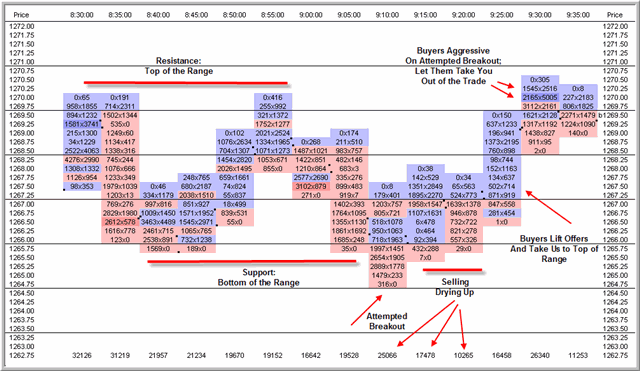How trading strategy and psychology fit together
One of the things I try to emphasize to traders
is that many minutes and hours of preparation can go into a single good trade
idea. This preparation not only includes the time taken prior to the market open
to research ideas and scan charts, but also includes the months and years of
learning you have accumulated as an active market trader.
What I’d like to do is take a single period from my Thursday trading and walk
you through the preparation that was involved. Let’s take it step by step:
- Thursday morning begins at 5:30 AM and a
review of Asian and European markets, as well as the overnight ES futures. We
are sharply down, largely due to lingering fears regarding the aborted attempt
to bomb airliners going from London to the U.S. The first thought I have is
that the attempt fortunately was caught in time and that fears may be overdone
and eventually reversed. My gut tells me to lean bullish. I have seen too many
of these opening market scares reverse themselves and trap those acting on
panic. - I begin my research. We had two consecutive
outside days on Tuesday and Wednesday and, as I wrote in my research blog,
this rare occurrence tended to be bullish in the past. I also found that down
days after outside days tend to be reversed in the short-run. This also has me
leaning to the long side. - The market opens with a pop to the upside,
then sells off hard, but holds at 1265.75, above the low price for the
overnight session. I’m a buyer at 8:45 AM CT and sell out at 8:56 AM, taking
over two points out of the trade once trade slows down near the top of the
opening range. - The market returns from the top of its range
at 1270 back to the low of the morning range at 1265.75–and then trades lower
on an attempted breakout. The five-minute chart below shows the resistance and
support from the morning session and the breakout move.

- I decide to not chase the breakout. My
research has me bullish, and I see a real possibility that aggressive sellers
on the breakout will be trapped if we don’t follow through to the downside.
Notice how some of our best trading decisions are decisions to not trade. - Sure enough, selling dries up in the next ten
minutes–all the while staying above the low from overnight. I now draw on my
experience to remind myself that (false) breakouts that return to their prior
range tend to trade through that range. As a result, I’m a buyer at 9:25 AM
CT. - By 9:33 AM CT, I can see buyers getting
overeager to jump on the attempted breakout to new highs. I let the buyers
take me out of the trade for nearly three points of profit.
Notice how the trading strategy and the trading
psychology fit together: I formulated my strategy based on research, waited
patiently for setups that told me sellers were running out of steam, and then
traded in the direction of my morning plan, allowing market action to take me
out of the trades. I minimized my time/risk in the market (less than 20
minutes), but pulled out over five points of profit while taking little heat.
That tells me my execution was good. Observe the favorable risk/reward on the
trades: if we had printed new lows, I was prepared to exit, but I stood to take
much more out of the trades if they went my way. While the trade was on, I was
carefully observing volume at the offer and volume at the bid price. I stayed in
the trade as long as buyers were more aggressive than sellers (color coded
blue).
I would easily estimate that several hours of direct preparation (and years of
trading experience) went into those 20 minutes of trading. I wasn’t trading for
excitement or because of hot tips. I waited until my strategy (buying after
market panic; buying after outside days) and tactics (buying when selling dries
up during the day) were aligned and then managed the trade based on order flow:
how much was trading and at which prices (bid/offer).
The best trades always occur at the nexus of strategy, tactics, and execution.
Thursday was a winning day, and writing this column is part of my next day’s
preparation to learn from what I did right. Later in the morning I missed a
trade that should have gone my way. I will be reviewing that miss and learning
from it as well prior to Friday’s open. Not every trade and not every day can be
a winner, but every trade and every day should be a learning experience.
Brett N. Steenbarger, Ph.D. is Associate Clinical Professor of
Psychiatry and Behavioral Sciences at SUNY Upstate Medical University in
Syracuse, NY and author of The Psychology of Trading (Wiley, 2003). As Director
of Trader Development for Kingstree Trading, LLC in Chicago, he has mentored
numerous professional traders and coordinated a training program for traders. An
active trader of the stock indexes, Brett utilizes statistically-based pattern
recognition for intraday trading. Brett does not offer commercial services to
traders, but maintains an archive of articles and a trading blog at
www.brettsteenbarger.com and a
blog of market analytics at
www.traderfeed.blogspot.com. His book, Enhancing Trader Performance,
is due for publication this fall (Wiley).
